Types and keys of tubas
Tubas come in all shapes and sizes, and there is often some confusion as to what is what.
This information is already commonplace to most tubists, however it is info that possibly gets asked the most by folks on the "outside".
Keys of tubas:
Normally, tubas come in 4 different keys, and are separated into two classes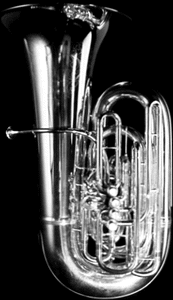 :
:
"bass" and "contrabass"
The "key" of the tuba refers to its "open" note series. Most of the time, tuba music is not transposed (except for some European band music). Instead of playing differently transposed parts like different keyed woodwinds would do, tubas read bass clef concert pitched parts that sound exactly in the octave written. Rather than reading transposed parts for different keyed horns, tuba players use a different set of fingerings for each horn – the same normal brass instrument pattern, starting on what the open note / key of the horn may be. Often times selection of what horn to use is left up to the player, depending on the part, musical traditions of both the music and ensemble, and simple playability.
Tubas in the keys Bb (known as BBb) and C (known as CC) are considered "contrabass" tubas. These are your "standard", most common sized tubas.
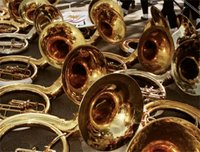 BBb is probably the most common. This is usually what most players start on (in the USA anyway), and includes most modern sousaphones as well. This is the tuba of choice for many amateurs, as well as some European orchestral players. BBb tubas are easier / more in tune in flat keys, but more difficult in sharp keys.
BBb is probably the most common. This is usually what most players start on (in the USA anyway), and includes most modern sousaphones as well. This is the tuba of choice for many amateurs, as well as some European orchestral players. BBb tubas are easier / more in tune in flat keys, but more difficult in sharp keys.
CC tubas sound, for the most part, exactly like a BBb tuba. Th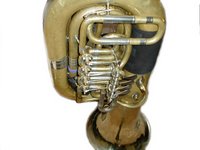 ough because of where the open series lays, CC tubas are a bit more flexible in all keys. The CC tuba is my personal tuba of choice, giving me the most level playing field and repertoire of sounds vs. key flexibility. It is pretty much generally accepted that the CC is the most flexible of all, and is the horn of choice for most orchestral players. For debatable reasons, most players do not start on CC until college.
ough because of where the open series lays, CC tubas are a bit more flexible in all keys. The CC tuba is my personal tuba of choice, giving me the most level playing field and repertoire of sounds vs. key flexibility. It is pretty much generally accepted that the CC is the most flexible of all, and is the horn of choice for most orchestral players. For debatable reasons, most players do not start on CC until college.
Tubas in Eb and F are considered "bass tubas". These horns are pitched higher than the contrabass tubas, and are generally smaller in size and lighter in sound. It is easier to play higher notes on the bass tuba with more clarity and delicate sound, but bass tubas usually lack the girth and thickness of sound of a contrabass tuba.
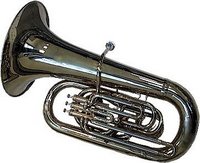 Tubas in Eb are usually the tuba of choice for many British tuba players, but are also a favorite for many solo artists as well. The Eb tuba is most often (but not always) an upright, piston-valved horn. Some older sousaphones are in Eb. British brass bands pair up Eb and Bb tubas.
Tubas in Eb are usually the tuba of choice for many British tuba players, but are also a favorite for many solo artists as well. The Eb tuba is most often (but not always) an upright, piston-valved horn. Some older sousaphones are in Eb. British brass bands pair up Eb and Bb tubas.
Tubas in F are becoming the most common horn for much solo playing, due to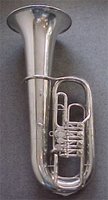 their fine clarity in the upper registers – some having more of a euphonium-like sound, more than a traditional tuba sound. F tubas are often (but not always) rotary-valved horns and are the smallest horns of the basic tuba family. F tubas are not usually suited well for large ensemble work as many F tubas have a weak low range. To compensate for this inefficiency, extra valves are added, so most professional F tubas now come with 6 valves to aid in the playing of these difficult lower notes. However, F tuba design has improved greatly over the last couple of decades and these inefficiencies are considerably less than they used to be.
their fine clarity in the upper registers – some having more of a euphonium-like sound, more than a traditional tuba sound. F tubas are often (but not always) rotary-valved horns and are the smallest horns of the basic tuba family. F tubas are not usually suited well for large ensemble work as many F tubas have a weak low range. To compensate for this inefficiency, extra valves are added, so most professional F tubas now come with 6 valves to aid in the playing of these difficult lower notes. However, F tuba design has improved greatly over the last couple of decades and these inefficiencies are considerably less than they used to be.
Numbers of valves:
Most brass instruments have 3 valves, which is all that are needed for the basic chromatic scale (all brass instruments use the same pattern). Tubas however spend so much time on the low end of the scale, that extra valves are added for better intonation, as well as to activate some extreme low-end notes.
The 4th, 5th, and 6th valves are alternate valves.
The standard valves on a brass instrument are like this:
The second valve is the shortest (length of tubing) valve
The first valve is twice as long as the second valve.
The third valve is the same length as the first and second combined, but a tad longer (flatter).
Fourth valves are the same as the first and third valves, but a little flatter.
Fifth valve can either be a flat first valve, or a flat second and third valve combination (and are interchangeable on many tubas)
The sixth valve is used when a player desires both options of the fifth valve.
BBb tubas usually have 3 or 4 valves, CC tubas usually have 4 or 5 valves, Eb tubas have 3 or 4 valves, and F tubas sometimes have 4, but usually have 5 or 6.
Sizes:
A standard tuba size is now known as 4/4. The smallest tubas are known as 3/4, and the larger tubas, (sometimes called a BAT – you figure out the acronym) used mainly for orchestral music, are called 5/4 or 6/4. This denotation has nothing to do with length or key, it has to do with pipe diameter (known as “bore size”) and bell size. Any key of tuba can come in pretty much any size.
Modern Valve styles:
Piston valves: These are like standard trumpet valves, with a button that is attached directly to the valve and lowers it, activating a second set of tubing.
Rotary valves: These are like standard French horn valves and consist of a paddle-like lever connected to a mechanical linkage which spins a round valve around, selecting the other set of tubing.
Traditionally, Bb and Eb tubas have been "top-action" piston valved horns, which is an English style, while CC and F tubas have traditionally been "front-action" rotary valved, German style horns. HOWEVER, this is not the norm any more, and any tuba is available in any configuration, depending on the maker and player’s preference.
Other tuba-related horns:
Euphonium: Sometimes erroneously called known a "tenor tuba", this horn is pitched in Bb, this is the tuba’s smaller cousin and plays an octave above the tuba, the range of a trombone. It is often played by trombone players and is very similar to the baritone horn (same length, just different tubing diameter proportions) The euphonium is used primarily in band music, but has recently gained a great reputation as a dynamic solo instrument due to its superb lyric quality. Some early euphoniums would have two bells, one larger and upright, and a smaller bell facing forward, for a brighter, more baritone or trombone-like sound. The Tenor Tuba is a similar, antiquated version, but has a more bass-tuba like bore and larger mouthpiece.
Sousaphone: Named for and developed by famous American bandmaster John Phillip Sousa, these horns are basically large Bb tubas that are wrapped in a circular shape to be worn over the body for mobility and use while standing or marching. With a greatly exaggerated bell, these horns are designed for outdoor use. Originally, Sousaphones had an upright bell (known as a "raincatcher") but now have a bell that faces forward. Sousaphones are most often seen in high school or college marching bands, but are also the horn of choice for many New Orleans style brass bands.
Helicon: This is the predecessor to the sousaphone and is also round to go around the body, but the bell is usually smaller and faces up at an angle. Helicons can come in pretty much any key or size, as to where Sousaphones are most often found only in Bb.
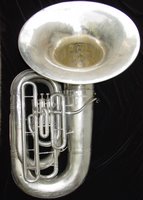 Recording bass: This is actually an older, standard tuba, usually in Bb, with an exaggerated, forward facing bell, much like the bell of a modern sousaphone. These were used in bands and orchestras in the earlier 20th century to aim the tuba sound directly at the microphone. These tubas often had an interchangeable upright bell for standard concerts. Some of these are still in use today by hobbyists and in school bands that have not updated their equipment. *addendum: I was just notified that a few college bands march an entire section of these on the field carrying them in front of the body with straps! Ouch!!
Recording bass: This is actually an older, standard tuba, usually in Bb, with an exaggerated, forward facing bell, much like the bell of a modern sousaphone. These were used in bands and orchestras in the earlier 20th century to aim the tuba sound directly at the microphone. These tubas often had an interchangeable upright bell for standard concerts. Some of these are still in use today by hobbyists and in school bands that have not updated their equipment. *addendum: I was just notified that a few college bands march an entire section of these on the field carrying them in front of the body with straps! Ouch!!
Cimbasso: This is an instrument that is sort of a hybrid tuba/bass trombone and is used primarily as the bass of the orchestral brass section in Italian opera music. This instrument is usually pitched in F and looks like a skinny, upright tuba with a downward facing trombone-like bell. The sound can be light, but also very harsh at times.
GG contrabass bugle: This instrument is pitched in G basso – below a standard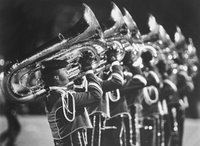 tuba. These were primarily used in drum and bugle corps in the 1970’s through the 1990’s, and some are still in use today. They are shaped like standard upright tuba, but are played carried on the left shoulder with the bell facing forward. Through the 70’s they had two valves: one piston, one rotary. In the 80’s they had two piston valves, and in the 90’s they had 3 piston valves. . Plagued with intonation problems and difficulty to play, most corps have recently dropped their use in favor of Bb tubas, but some smaller and more traditionalist corps still use them.
tuba. These were primarily used in drum and bugle corps in the 1970’s through the 1990’s, and some are still in use today. They are shaped like standard upright tuba, but are played carried on the left shoulder with the bell facing forward. Through the 70’s they had two valves: one piston, one rotary. In the 80’s they had two piston valves, and in the 90’s they had 3 piston valves. . Plagued with intonation problems and difficulty to play, most corps have recently dropped their use in favor of Bb tubas, but some smaller and more traditionalist corps still use them.
BBb Marching tuba: These horns look much like the GG contrabass but are in the key of Bb. Usually 3/4, 4/4 or 5/4 in size, having 3 or 4 valves. Used in modern drum and bugle corps and many high school marching bands. Many of these horns are convertible British-style upright valved concert horns with an exchangable leadpipe.
C French tuba: Having 6 piston valves and playing an octave above modern tubas, the French tuba was very first actual tuba and was designed to replace the ophecleide as the bass of the orchestral brass section. Felix Mendelssohn was the first composer known to write for this instrument in A Midsummer Night’s Dream. Hector Berlioz heard a performance of this and then rescored his famous Symphonie Fantastique for (French) tubas. French tubas are rarely seen today.
 Ophecleide: This is the predecessor to the tuba and looks like combination of a baritone saxophone and a bassoon, but is played with a brass mouthpiece. Prior to tuba times, in early romantic orchestral composition, this was the bottom of the brass section. It was a very inefficient instrument, only sounding good in certain keys. Due to this, several players were employed, playing various keys of ophecleides at the same time to therefore cover the complete chromatic range when needed. Ophecleides are not used much anymore, but are around in historical circles and are sometimes used on recordings of "period" instruments.
Ophecleide: This is the predecessor to the tuba and looks like combination of a baritone saxophone and a bassoon, but is played with a brass mouthpiece. Prior to tuba times, in early romantic orchestral composition, this was the bottom of the brass section. It was a very inefficient instrument, only sounding good in certain keys. Due to this, several players were employed, playing various keys of ophecleides at the same time to therefore cover the complete chromatic range when needed. Ophecleides are not used much anymore, but are around in historical circles and are sometimes used on recordings of "period" instruments.
Serpent: This was the original bass horn of the cornet family (when they were still made of wood and/or leather) and was put into use in the late sixteenth century. The predecessor of the ophecleide, this horn was shaped like a big "S", had holes like a recorder and was very difficult to play. The serpent still shows up in period / historic music ensembles.
Laquer:
Silver vs. Brass
All tubas are made of brass, but they come in different types of finishes. Most tubas have a thin coat of laquer, usually silver, brass, or clearcoat. Some (like my tuba) have no laquer at all and sport the raw brass.
Does it affect the sound? Hard to say... some say it does, but in reality, physics says it probably does not. There is much debate on this subject. Tradition probably has as much to do with this as anything, as do aesthetics. Personally I do think that the raw brass on my horn does affect the sound a bit (the person I bought it from, who had removed the laquer, said it made a big difference to remove it).
Obviously the gauge (thickness) of the brass has an impact on the sound.
Another debated factor is the age of the brass. Some claim that the chemical makeup of the brass changes slightly over time. Again, always referring back to Mr. Jacobs prized old York (now owned by the Chicago Symphony and played by Gene Pokorny) as the "gold (silver?) standard" in tuba composition. It has been copied my many tuba makers - the "stradivarius" of tubas.
There is also a trend of players cryogenically freezing newer horns to try to accelerate the aging process. ...another debated technique that is up to the preference of the player.
No other wind instrument comes in as many sizes and shapes as the tuba, and no other wind instrument is as often misunderstood.
This information is already commonplace to most tubists, however it is info that possibly gets asked the most by folks on the "outside".
Keys of tubas:
Normally, tubas come in 4 different keys, and are separated into two classes
 :
:"bass" and "contrabass"
The "key" of the tuba refers to its "open" note series. Most of the time, tuba music is not transposed (except for some European band music). Instead of playing differently transposed parts like different keyed woodwinds would do, tubas read bass clef concert pitched parts that sound exactly in the octave written. Rather than reading transposed parts for different keyed horns, tuba players use a different set of fingerings for each horn – the same normal brass instrument pattern, starting on what the open note / key of the horn may be. Often times selection of what horn to use is left up to the player, depending on the part, musical traditions of both the music and ensemble, and simple playability.
Tubas in the keys Bb (known as BBb) and C (known as CC) are considered "contrabass" tubas. These are your "standard", most common sized tubas.
 BBb is probably the most common. This is usually what most players start on (in the USA anyway), and includes most modern sousaphones as well. This is the tuba of choice for many amateurs, as well as some European orchestral players. BBb tubas are easier / more in tune in flat keys, but more difficult in sharp keys.
BBb is probably the most common. This is usually what most players start on (in the USA anyway), and includes most modern sousaphones as well. This is the tuba of choice for many amateurs, as well as some European orchestral players. BBb tubas are easier / more in tune in flat keys, but more difficult in sharp keys.CC tubas sound, for the most part, exactly like a BBb tuba. Th
 ough because of where the open series lays, CC tubas are a bit more flexible in all keys. The CC tuba is my personal tuba of choice, giving me the most level playing field and repertoire of sounds vs. key flexibility. It is pretty much generally accepted that the CC is the most flexible of all, and is the horn of choice for most orchestral players. For debatable reasons, most players do not start on CC until college.
ough because of where the open series lays, CC tubas are a bit more flexible in all keys. The CC tuba is my personal tuba of choice, giving me the most level playing field and repertoire of sounds vs. key flexibility. It is pretty much generally accepted that the CC is the most flexible of all, and is the horn of choice for most orchestral players. For debatable reasons, most players do not start on CC until college.Tubas in Eb and F are considered "bass tubas". These horns are pitched higher than the contrabass tubas, and are generally smaller in size and lighter in sound. It is easier to play higher notes on the bass tuba with more clarity and delicate sound, but bass tubas usually lack the girth and thickness of sound of a contrabass tuba.
 Tubas in Eb are usually the tuba of choice for many British tuba players, but are also a favorite for many solo artists as well. The Eb tuba is most often (but not always) an upright, piston-valved horn. Some older sousaphones are in Eb. British brass bands pair up Eb and Bb tubas.
Tubas in Eb are usually the tuba of choice for many British tuba players, but are also a favorite for many solo artists as well. The Eb tuba is most often (but not always) an upright, piston-valved horn. Some older sousaphones are in Eb. British brass bands pair up Eb and Bb tubas.Tubas in F are becoming the most common horn for much solo playing, due to
 their fine clarity in the upper registers – some having more of a euphonium-like sound, more than a traditional tuba sound. F tubas are often (but not always) rotary-valved horns and are the smallest horns of the basic tuba family. F tubas are not usually suited well for large ensemble work as many F tubas have a weak low range. To compensate for this inefficiency, extra valves are added, so most professional F tubas now come with 6 valves to aid in the playing of these difficult lower notes. However, F tuba design has improved greatly over the last couple of decades and these inefficiencies are considerably less than they used to be.
their fine clarity in the upper registers – some having more of a euphonium-like sound, more than a traditional tuba sound. F tubas are often (but not always) rotary-valved horns and are the smallest horns of the basic tuba family. F tubas are not usually suited well for large ensemble work as many F tubas have a weak low range. To compensate for this inefficiency, extra valves are added, so most professional F tubas now come with 6 valves to aid in the playing of these difficult lower notes. However, F tuba design has improved greatly over the last couple of decades and these inefficiencies are considerably less than they used to be.Numbers of valves:
Most brass instruments have 3 valves, which is all that are needed for the basic chromatic scale (all brass instruments use the same pattern). Tubas however spend so much time on the low end of the scale, that extra valves are added for better intonation, as well as to activate some extreme low-end notes.
The 4th, 5th, and 6th valves are alternate valves.
The standard valves on a brass instrument are like this:
The second valve is the shortest (length of tubing) valve
The first valve is twice as long as the second valve.
The third valve is the same length as the first and second combined, but a tad longer (flatter).
Fourth valves are the same as the first and third valves, but a little flatter.
Fifth valve can either be a flat first valve, or a flat second and third valve combination (and are interchangeable on many tubas)
The sixth valve is used when a player desires both options of the fifth valve.
BBb tubas usually have 3 or 4 valves, CC tubas usually have 4 or 5 valves, Eb tubas have 3 or 4 valves, and F tubas sometimes have 4, but usually have 5 or 6.
Sizes:
A standard tuba size is now known as 4/4. The smallest tubas are known as 3/4, and the larger tubas, (sometimes called a BAT – you figure out the acronym) used mainly for orchestral music, are called 5/4 or 6/4. This denotation has nothing to do with length or key, it has to do with pipe diameter (known as “bore size”) and bell size. Any key of tuba can come in pretty much any size.
Modern Valve styles:
Piston valves: These are like standard trumpet valves, with a button that is attached directly to the valve and lowers it, activating a second set of tubing.
Rotary valves: These are like standard French horn valves and consist of a paddle-like lever connected to a mechanical linkage which spins a round valve around, selecting the other set of tubing.

Preference is completely up to the player. Piston valves tend to have a bit more flexibility (between notes), and rotary valves tend to be a bit more "click" like in their transition between notes. Currently the trend is towards piston valves for many orchestral tubists, probably due to the sound of the late Arnold Jacobs, the most famous orchestral tubist and brass pedagogue of all time, and his famous monster York CC tuba.
Traditionally, Bb and Eb tubas have been "top-action" piston valved horns, which is an English style, while CC and F tubas have traditionally been "front-action" rotary valved, German style horns. HOWEVER, this is not the norm any more, and any tuba is available in any configuration, depending on the maker and player’s preference.
Other tuba-related horns:
Euphonium: Sometimes erroneously called known a "tenor tuba", this horn is pitched in Bb, this is the tuba’s smaller cousin and plays an octave above the tuba, the range of a trombone. It is often played by trombone players and is very similar to the baritone horn (same length, just different tubing diameter proportions) The euphonium is used primarily in band music, but has recently gained a great reputation as a dynamic solo instrument due to its superb lyric quality. Some early euphoniums would have two bells, one larger and upright, and a smaller bell facing forward, for a brighter, more baritone or trombone-like sound. The Tenor Tuba is a similar, antiquated version, but has a more bass-tuba like bore and larger mouthpiece.
Sousaphone: Named for and developed by famous American bandmaster John Phillip Sousa, these horns are basically large Bb tubas that are wrapped in a circular shape to be worn over the body for mobility and use while standing or marching. With a greatly exaggerated bell, these horns are designed for outdoor use. Originally, Sousaphones had an upright bell (known as a "raincatcher") but now have a bell that faces forward. Sousaphones are most often seen in high school or college marching bands, but are also the horn of choice for many New Orleans style brass bands.
Helicon: This is the predecessor to the sousaphone and is also round to go around the body, but the bell is usually smaller and faces up at an angle. Helicons can come in pretty much any key or size, as to where Sousaphones are most often found only in Bb.
 Recording bass: This is actually an older, standard tuba, usually in Bb, with an exaggerated, forward facing bell, much like the bell of a modern sousaphone. These were used in bands and orchestras in the earlier 20th century to aim the tuba sound directly at the microphone. These tubas often had an interchangeable upright bell for standard concerts. Some of these are still in use today by hobbyists and in school bands that have not updated their equipment. *addendum: I was just notified that a few college bands march an entire section of these on the field carrying them in front of the body with straps! Ouch!!
Recording bass: This is actually an older, standard tuba, usually in Bb, with an exaggerated, forward facing bell, much like the bell of a modern sousaphone. These were used in bands and orchestras in the earlier 20th century to aim the tuba sound directly at the microphone. These tubas often had an interchangeable upright bell for standard concerts. Some of these are still in use today by hobbyists and in school bands that have not updated their equipment. *addendum: I was just notified that a few college bands march an entire section of these on the field carrying them in front of the body with straps! Ouch!!Cimbasso: This is an instrument that is sort of a hybrid tuba/bass trombone and is used primarily as the bass of the orchestral brass section in Italian opera music. This instrument is usually pitched in F and looks like a skinny, upright tuba with a downward facing trombone-like bell. The sound can be light, but also very harsh at times.
GG contrabass bugle: This instrument is pitched in G basso – below a standard
 tuba. These were primarily used in drum and bugle corps in the 1970’s through the 1990’s, and some are still in use today. They are shaped like standard upright tuba, but are played carried on the left shoulder with the bell facing forward. Through the 70’s they had two valves: one piston, one rotary. In the 80’s they had two piston valves, and in the 90’s they had 3 piston valves. . Plagued with intonation problems and difficulty to play, most corps have recently dropped their use in favor of Bb tubas, but some smaller and more traditionalist corps still use them.
tuba. These were primarily used in drum and bugle corps in the 1970’s through the 1990’s, and some are still in use today. They are shaped like standard upright tuba, but are played carried on the left shoulder with the bell facing forward. Through the 70’s they had two valves: one piston, one rotary. In the 80’s they had two piston valves, and in the 90’s they had 3 piston valves. . Plagued with intonation problems and difficulty to play, most corps have recently dropped their use in favor of Bb tubas, but some smaller and more traditionalist corps still use them.BBb Marching tuba: These horns look much like the GG contrabass but are in the key of Bb. Usually 3/4, 4/4 or 5/4 in size, having 3 or 4 valves. Used in modern drum and bugle corps and many high school marching bands. Many of these horns are convertible British-style upright valved concert horns with an exchangable leadpipe.
C French tuba: Having 6 piston valves and playing an octave above modern tubas, the French tuba was very first actual tuba and was designed to replace the ophecleide as the bass of the orchestral brass section. Felix Mendelssohn was the first composer known to write for this instrument in A Midsummer Night’s Dream. Hector Berlioz heard a performance of this and then rescored his famous Symphonie Fantastique for (French) tubas. French tubas are rarely seen today.
 Ophecleide: This is the predecessor to the tuba and looks like combination of a baritone saxophone and a bassoon, but is played with a brass mouthpiece. Prior to tuba times, in early romantic orchestral composition, this was the bottom of the brass section. It was a very inefficient instrument, only sounding good in certain keys. Due to this, several players were employed, playing various keys of ophecleides at the same time to therefore cover the complete chromatic range when needed. Ophecleides are not used much anymore, but are around in historical circles and are sometimes used on recordings of "period" instruments.
Ophecleide: This is the predecessor to the tuba and looks like combination of a baritone saxophone and a bassoon, but is played with a brass mouthpiece. Prior to tuba times, in early romantic orchestral composition, this was the bottom of the brass section. It was a very inefficient instrument, only sounding good in certain keys. Due to this, several players were employed, playing various keys of ophecleides at the same time to therefore cover the complete chromatic range when needed. Ophecleides are not used much anymore, but are around in historical circles and are sometimes used on recordings of "period" instruments.Serpent: This was the original bass horn of the cornet family (when they were still made of wood and/or leather) and was put into use in the late sixteenth century. The predecessor of the ophecleide, this horn was shaped like a big "S", had holes like a recorder and was very difficult to play. The serpent still shows up in period / historic music ensembles.
Laquer:
Silver vs. Brass
All tubas are made of brass, but they come in different types of finishes. Most tubas have a thin coat of laquer, usually silver, brass, or clearcoat. Some (like my tuba) have no laquer at all and sport the raw brass.
Does it affect the sound? Hard to say... some say it does, but in reality, physics says it probably does not. There is much debate on this subject. Tradition probably has as much to do with this as anything, as do aesthetics. Personally I do think that the raw brass on my horn does affect the sound a bit (the person I bought it from, who had removed the laquer, said it made a big difference to remove it).
Obviously the gauge (thickness) of the brass has an impact on the sound.
Another debated factor is the age of the brass. Some claim that the chemical makeup of the brass changes slightly over time. Again, always referring back to Mr. Jacobs prized old York (now owned by the Chicago Symphony and played by Gene Pokorny) as the "gold (silver?) standard" in tuba composition. It has been copied my many tuba makers - the "stradivarius" of tubas.
There is also a trend of players cryogenically freezing newer horns to try to accelerate the aging process. ...another debated technique that is up to the preference of the player.
No other wind instrument comes in as many sizes and shapes as the tuba, and no other wind instrument is as often misunderstood.


<< Home